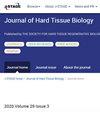A Study of Bone Formation around Titanium Implants Using Frozen Sections
IF 0.4
4区 医学
Q4 ENGINEERING, BIOMEDICAL
引用次数: 3
Abstract
Titanium is most widely used for implants. Almost all the histological studies of the implants have been carried out with polished specimens and the use of frozen sections are challenging. This study focused to define the formation process of bone around titanium with frozen sections made from tissue implanted with a commercially pure titanium foil (Tifoil). We inserted the Ti-foil with a 30-μm thickness into rat femurs and extracted it after 1, 3, 5, 7, 10, 15, and 30 days. After freezing, they were sliced into 3-μm thick serial frozen sections and the sections were used for hematoxylin and eosin (H&E) staining, Masson trichrome staining, Alizarin Red S staining, enzymatic staining (ALPase and TRAPase), immunostaining (osteopontin, osteocalcin, and collagen type I), and elemental analysis. At 1 day after the implantation, the area around the Ti-foil was filled with blood and there are no collagen fibers and no proliferated cells in the area. At 3 days, the new collagen fibers were observed on the marrow side of the blood clot. The proliferated cells were observed around the fibers and they were positive for immunostaining to osteopontin, osteocalcin, and collagen type I. After 5 days, calcium precipitation was observed on the newly formed collagen fibers. After 7 days, the calcification progressed and started to reach the Ti-foil surface. After 10 days, calcification progressed to the area around the Ti-foil. At 15 days, a remarkable bone resorption appears on the marrow side. At 30 days, further resorption was observed and bony tissue was seen on the Ti-foil surface only. These results clearly showed that the bone around the Ti-foil is formed after undergoing the blood clotting process around the Ti-foil, osteoblast and fibroblast proliferation, calcium precipitation on the collagen fibers, bone formation around the Ti-foil, and bone resorption by osteoclasts.钛种植体周围骨形成的冷冻切片研究
钛被广泛用于植入物。几乎所有种植体的组织学研究都是用抛光标本进行的,使用冷冻切片是具有挑战性的。本研究的重点是通过植入商业纯钛箔(Tifoil)的组织制成的冷冻切片来确定钛周围骨骼的形成过程。将厚度为30 μm的Ti-foil植入大鼠股骨,并于1、3、5、7、10、15和30天后取出。冷冻后,切片成3 μm厚的连续冷冻切片,切片用于苏木精和伊红(H&E)染色、马松三色染色、茜素红S染色、酶染色(ALPase和TRAPase)、免疫染色(骨桥蛋白、骨钙素和I型胶原)和元素分析。植入后第1天,铝箔周围充血,无胶原纤维,无增殖细胞。第3天,在血凝块的骨髓一侧观察到新的胶原纤维。纤维周围可见增殖的细胞,骨桥蛋白、骨钙素、ⅰ型胶原免疫染色阳性。5天后,新形成的胶原纤维上可见钙沉淀。7天后,钙化进展并开始到达铝箔表面。10天后,钙化进展到铝箔周围区域。第15天,骨髓一侧出现明显的骨吸收。第30天,观察到进一步的吸收,仅在钛箔表面可见骨组织。这些结果清楚地表明,钛箔周围的骨是经过钛箔周围的血液凝固过程、成骨细胞和成纤维细胞增殖、胶原纤维上的钙沉淀、钛箔周围的骨形成以及破骨细胞的骨吸收后形成的。
本文章由计算机程序翻译,如有差异,请以英文原文为准。
求助全文
约1分钟内获得全文
求助全文
来源期刊

Journal of Hard Tissue Biology
ENGINEERING, BIOMEDICAL-
CiteScore
0.90
自引率
0.00%
发文量
28
审稿时长
6-12 weeks
期刊介绍:
Information not localized
 求助内容:
求助内容: 应助结果提醒方式:
应助结果提醒方式:


